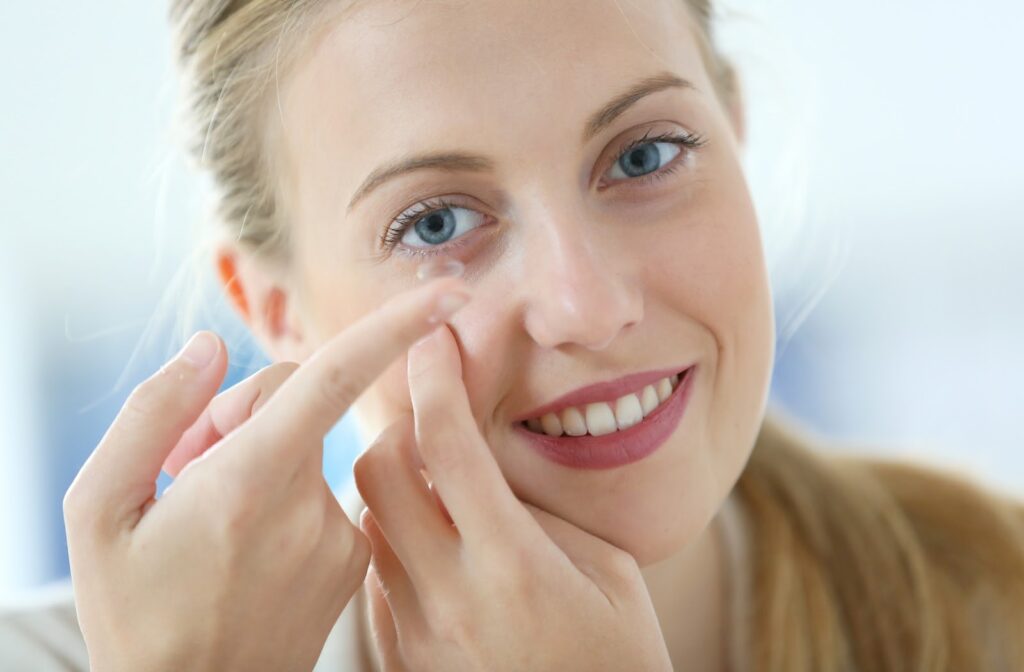Contact lenses can serve as a great alternative option for eyeglasses. If you are curious about trying contact lenses, you will need to get a contact lens specific eye exam. A contact lens eye exam will involve extra measurements that are not included in a comprehensive eye exam. The use of additional tools will allow your optometrist to get a detailed map of your eye and determine the best contact lenses for your specific needs.
How Are Contact Lens Eye Exams Different Than Comprehensive Eye Exams?
Comprehensive Eye Exams
A comprehensive eye exam typically involves different tests that are used to determine the visual acuity of your eyes. This exam will give your optometrist an idea of what your current prescription is and can help assess the current state of your eye health. Some of the tests your optometrist will perform are:
Contact Lens Eye Exams
Compared to a regular comprehensive eye exam, a contact lens specific eye exam involves additional measurements that will help determine the shape and size of your eye’s surface and what kind of contact lens is best for you.
After your contact lens eye exam, you and your optometrist can discuss your color preferences, how often you want to replace your contact lenses, and how hard or soft you want your contact lenses to be.
How Often Should You Get a Contact Lens Eye Examination?
Regular Comprehensive Eye Exams
- Ages 19-64: Once every two years
- Ages 65 & over: Once per year
- Children ages 5-18: Once per year
Contact Lens Eye Exams
- After your first fitting, you will undergo a trial period of wearing your new contact lenses based on the recommendation of your optometrist. Upon completion of this trial period, you will need to come in for another evaluation. If your current contact lenses are bothering you, you can ask your optometrist about switching brands or types of lenses.
- If your new contact lenses are comfortable, then a contact lens specific eye exam should be performed on an annual basis regardless of age.
When Do Contact Lens Prescriptions Expire?
Most contact lens prescriptions are valid for at least one year. Usually, the expiration date of your prescription will be written on it. Once your prescription expires, you typically won’t be able to buy more contact lenses until it has been updated. This will require an eye exam to ensure that your prescription is correct and your current contact lenses aren’t causing any damage to your eyes.
If you are diagnosed with a contact lens related problem, you will usually not have to give up on wearing contact lenses. In most cases, the solution will be to change to a different type of lens or a different contact lens solution.

Additional Measurements Included in Contact Lens Eye Exams
Corneal Curvature
To assure that the curve of a contact lens properly fits the curve of your eye, one of our eye doctors will measure the curvature of the cornea or front surface of the eye. The curvature of the cornea is measured with an instrument called a keratometer, which will determine the appropriate curve for your contact lenses. If you have astigmatism, the curvature of your cornea will not be perfectly round and you will need a toric lens. In some cases, your eye doctor may decide to measure your cornea with a digital mapping of the corneal surface called corneal topography.
Pupil or Iris Size
Your eye doctor may measure the size of your pupil or your iris with an instrument called a biomicroscope or slit lamp, or may manually measure it with a ruler or card. This measurement is especially important if you are considering specialized lenses.
Tear Film Evaluation
Dry eye is one of the most common problems that affects contact lens wearers. If the lenses are not kept sufficiently hydrated and moist, they will become uncomfortable and your eyes will feel dry and irritated.
A tear film evaluation involves an eye doctor putting a drop of liquid dye on your eye and then viewing your tears with a slit lamp or by placing a special strip of paper under the lid to absorb the tears to see how much moisture is produced. If your tear film is weak, your eye doctor might recommend certain types of contact lenses that are better at maintaining the moisture of your eye.
Contact Lens Trial and Prescription
After deciding which pair of lenses could work best with your eyes, your eye doctor may have you try on a pair of lenses to confirm the fit and comfort before finalizing and ordering your lenses. The lenses will be inserted and kept in for 15-20 minutes before your doctor examines the fit, movement, and tearing in your eye. After this process, if the lenses appear to be a good fit, your eye doctor will complete the order for you.
Your eye doctor will also provide information and instruction on caring for your new lenses, including how to insert and remove your lenses, how long to wear them, and how to store them if relevant.
Booking an Appointment for a Contact Lens Exam
If you are curious about getting a prescription for contact lenses, booking an appointment with one of our optometrists is the best way to receive more information on contact lenses and contact lens eye exams.


